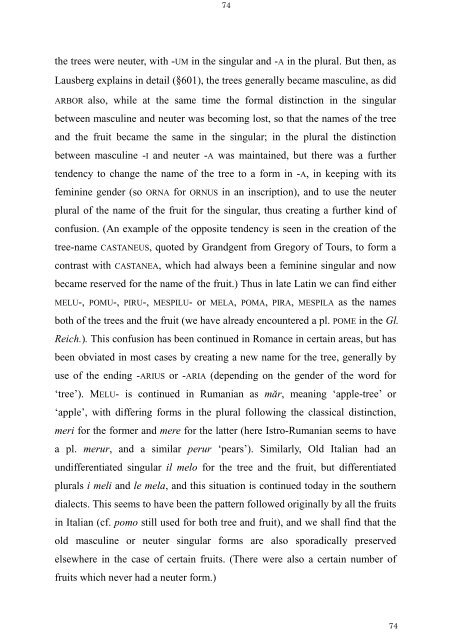The Latin Neuter Plurals in Romance - Page ON
The Latin Neuter Plurals in Romance - Page ON
The Latin Neuter Plurals in Romance - Page ON
Create successful ePaper yourself
Turn your PDF publications into a flip-book with our unique Google optimized e-Paper software.
74<br />
the trees were neuter, with -UM <strong>in</strong> the s<strong>in</strong>gular and -A <strong>in</strong> the plural. But then, as<br />
Lausberg expla<strong>in</strong>s <strong>in</strong> detail (§601), the trees generally became mascul<strong>in</strong>e, as did<br />
ARBOR also, while at the same time the formal dist<strong>in</strong>ction <strong>in</strong> the s<strong>in</strong>gular<br />
between mascul<strong>in</strong>e and neuter was becom<strong>in</strong>g lost, so that the names of the tree<br />
and the fruit became the same <strong>in</strong> the s<strong>in</strong>gular; <strong>in</strong> the plural the dist<strong>in</strong>ction<br />
between mascul<strong>in</strong>e -I and neuter -A was ma<strong>in</strong>ta<strong>in</strong>ed, but there was a further<br />
tendency to change the name of the tree to a form <strong>in</strong> -A, <strong>in</strong> keep<strong>in</strong>g with its<br />
fem<strong>in</strong><strong>in</strong>e gender (so ORNA for ORNUS <strong>in</strong> an <strong>in</strong>scription), and to use the neuter<br />
plural of the name of the fruit for the s<strong>in</strong>gular, thus creat<strong>in</strong>g a further k<strong>in</strong>d of<br />
confusion. (An example of the opposite tendency is seen <strong>in</strong> the creation of the<br />
tree-name CASTANEUS, quoted by Grandgent from Gregory of Tours, to form a<br />
contrast with CASTANEA, which had always been a fem<strong>in</strong><strong>in</strong>e s<strong>in</strong>gular and now<br />
became reserved for the name of the fruit.) Thus <strong>in</strong> late <strong>Lat<strong>in</strong></strong> we can f<strong>in</strong>d either<br />
MELU-, POMU-, PIRU-, MESPILU- or MELA, POMA, PIRA, MESPILA as the names<br />
both of the trees and the fruit (we have already encountered a pl. POME <strong>in</strong> the Gl.<br />
Reich.). This confusion has been cont<strong>in</strong>ued <strong>in</strong> <strong>Romance</strong> <strong>in</strong> certa<strong>in</strong> areas, but has<br />
been obviated <strong>in</strong> most cases by creat<strong>in</strong>g a new name for the tree, generally by<br />
use of the end<strong>in</strong>g -ARIUS or -ARIA (depend<strong>in</strong>g on the gender of the word for<br />
‘tree’). MELU- is cont<strong>in</strong>ued <strong>in</strong> Rumanian as măr, mean<strong>in</strong>g ‘apple-tree’ or<br />
‘apple’, with differ<strong>in</strong>g forms <strong>in</strong> the plural follow<strong>in</strong>g the classical dist<strong>in</strong>ction,<br />
meri for the former and mere for the latter (here Istro-Rumanian seems to have<br />
a pl. merur, and a similar perur ‘pears’). Similarly, Old Italian had an<br />
undifferentiated s<strong>in</strong>gular il melo for the tree and the fruit, but differentiated<br />
plurals i meli and le mela, and this situation is cont<strong>in</strong>ued today <strong>in</strong> the southern<br />
dialects. This seems to have been the pattern followed orig<strong>in</strong>ally by all the fruits<br />
<strong>in</strong> Italian (cf. pomo still used for both tree and fruit), and we shall f<strong>in</strong>d that the<br />
old mascul<strong>in</strong>e or neuter s<strong>in</strong>gular forms are also sporadically preserved<br />
elsewhere <strong>in</strong> the case of certa<strong>in</strong> fruits. (<strong>The</strong>re were also a certa<strong>in</strong> number of<br />
fruits which never had a neuter form.)<br />
74









